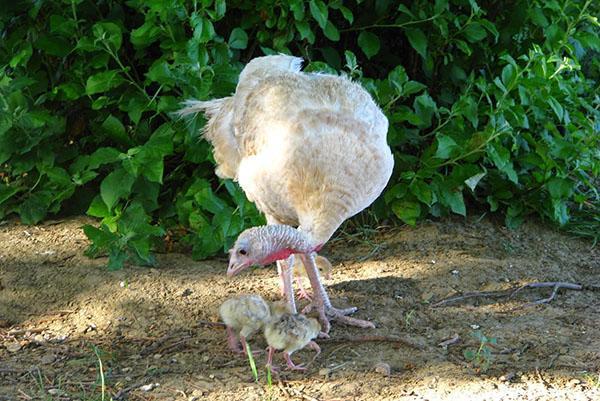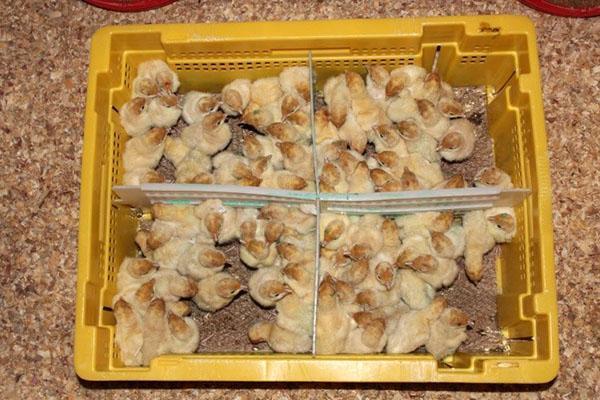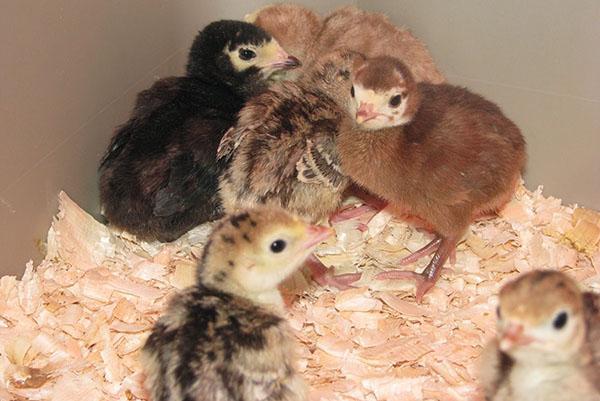Complete feeding of turkeys from day one is the key to success
 Turkeys in Russian households are the largest poultry, valued for their fast growth and excellent quality dietary meat. But in order for a bird to reach 10-30 kg in six months, it will take a lot of work and, above all, to arrange feeding of turkeys from the first day of their life.
Turkeys in Russian households are the largest poultry, valued for their fast growth and excellent quality dietary meat. But in order for a bird to reach 10-30 kg in six months, it will take a lot of work and, above all, to arrange feeding of turkeys from the first day of their life.
Like any newborn organism, a tiny turkey requires a lot of attention and almost constant care. At the beginning of life, the bird not only develops rapidly, but at the same time acclimatizes in an unfamiliar environment.
To accelerate the habituation, from the moment of birth, they create comfortable conditions for the chicks and, of course, offer fast-digesting food that provides all the needs of the turkey.
How to feed turkey poults in the first days of life? How to organize the feeding of a slightly grown and matured bird?
First turkey feed

The faster the chick receives the first food, the more active growth will be in the future. And as soon as the turkeys get to their permanent place of residence, they are offered:
- a diet adapted to the characteristics of digestion at this age;
- good-quality fresh food, which is digested as quickly as possible without lingering in the intestines and without causing any negative consequences for the development of the chick;
- balanced menu with a high, up to 25-30%, protein content.
 If from the first day the feeding of the turkey poults does not meet the needs of the rapidly developing poultry, stunting, disease and even death of the young cannot be avoided. This is especially noticeable with a lack of proteins. With a good appetite, the bird does not gain the prescribed weight, it can suffer from digestive disorders that exhaust and further weaken the body.
If from the first day the feeding of the turkey poults does not meet the needs of the rapidly developing poultry, stunting, disease and even death of the young cannot be avoided. This is especially noticeable with a lack of proteins. With a good appetite, the bird does not gain the prescribed weight, it can suffer from digestive disorders that exhaust and further weaken the body.
How to feed daily turkey poults at home? How to calculate the daily food requirement of pets?
Composition and consumption rates of feed for turkey poults
The table below shows the approximate daily feed intake for turkey chicks at different ages. Volumes are in grams.
 As a feed for turkey poults that have just been born, they offer wet mash, except for 3-4 types of grain, including:
As a feed for turkey poults that have just been born, they offer wet mash, except for 3-4 types of grain, including:
- cottage cheese;
- skimmed yogurt or reverse;
- wheat bran;
- boiled millet;
- chopped, and for very small chicks, grated, boiled eggs;
- meat and bone or fish meal.
 In addition, chopped carrots and juicy green onion feathers are added to the food. These ingredients will provide vitamins and support the digestion of day old chicks. For the same purpose, turkeys of the first day of life are advised to drink a mixture of nettle, alfalfa and carrot juices.
In addition, chopped carrots and juicy green onion feathers are added to the food. These ingredients will provide vitamins and support the digestion of day old chicks. For the same purpose, turkeys of the first day of life are advised to drink a mixture of nettle, alfalfa and carrot juices.
From the first day, when feeding turkey poults, they should not experience a shortage of food, but at the same time all feed should be as fresh as possible.
Wet mixtures are prepared in such a way that they are eaten in no more than half an hour. At elevated air temperatures, the pathogenic microflora in the nutrient medium develops most rapidly, therefore food residues in the places where the young are kept is a serious threat to the health and life of turkeys. Therefore in turkey care at home, in addition to feeding, they include the mandatory cleaning of the places assigned to the bird.
To facilitate access to food, feed for very young chicks is served on flat trays. In this case, you need to constantly monitor that the whole bird is full.
This can be done by probing the goiter after feeding. A hungry turkey has it empty. If you do not take urgent measures, for example, to plant the weak for supplementary feeding, by the age of one week there will be visible differences in the weight and size of the chicks.
Feeding turkeys from 10 days of age
If in the first days turkey poults are fed every two hours, then starting from 10 days of age, the frequency of food intake is gradually reduced. At the same time, the diet for young animals is significantly replenished. In addition to wet mixtures, in separate feeders, the chicks are offered dry food, half of which consists of grain skins, and an equal amount of sunflower meal and crushed peas. A small amount of chalk is added to the mixture as a mineral additive.
 Boiled potatoes are introduced into the menu for 10-day-old birds. At the beginning of such feeding, about 5–7 grams per head should fall, two-month-old turkeys consume 50–60 grams of root crops.
Boiled potatoes are introduced into the menu for 10-day-old birds. At the beginning of such feeding, about 5–7 grams per head should fall, two-month-old turkeys consume 50–60 grams of root crops.
Do not stop feeding turkey poults with protein-rich foods:
- meat and bone and fish meal or minced meat;
- baker's yeast;
- dairy products.
You can start a gradual transition to feeding not crushed, but whole grains no earlier than 40 days after the chicks are born. At the same time, it is still desirable to give a large grain of corn in a ground form.
Mineral and vitamin feed for turkey poults
Mineral supplements are necessary for poultry to meet the micronutrient requirements, mainly calcium. This element, which is the basis of bones and bird feathers, is vital for actively growing turkey poults. Therefore, from 10 days of age, turkey poultry includes foods rich in calcium and other minerals.
The crushed shell and the gravel that stimulates digestion are not mixed with dry food and are poured into separate containers.
Particular attention should be paid to vitamins when growing turkey poults. How to feed turkey poults at home so that they do not lack vitamins?
If from the first day of life, green onions have already been introduced into the feeding of the bird, then after a few days the "vitamin salad" is replenished with greens of forage grasses, for example, clover, alfalfa. Turkey poults are given chopped cabbage foliage, tops of garden crops: turnips, beets, carrots. Since chives, so beloved by turkeys, are thirsty, it is best to give them in the morning.
 The consumption of such a useful feed for turkeys should gradually increase. If at the age of one month, 50 grams of greens are prepared per chick, then by six months the bird eats three times more.
The consumption of such a useful feed for turkeys should gradually increase. If at the age of one month, 50 grams of greens are prepared per chick, then by six months the bird eats three times more.
Using compound feed for turkey poults
The use of compound feed gives excellent results. Ready-made specialized mixtures not only simplify feeding and caring for turkeys at home, but also make it possible to more accurately calculate the nutritional needs of young animals and prevent the development of dangerous infections. The compound feed is used as a dry grain mixture, and wet feed is also prepared on it.
 After 14 days of age, special mixed feed for turkey poults can become the basis of the diet of poultry. At 4 months of age, the livestock accustomed to dry feed is transferred to compound feed for adults.
After 14 days of age, special mixed feed for turkey poults can become the basis of the diet of poultry. At 4 months of age, the livestock accustomed to dry feed is transferred to compound feed for adults.
At the same time, one should not forget about the bird's need for water. Clean moisture must be available at all times. The smaller the chick, the more acutely it experiences thirst. The most dangerous in case of a lack of water is feeding with dry mixtures. Correctly organized feeding of turkeys from the first days and attentive care of young animals are the key to rapid growth and health of the bird.
Thank you for the interesting page, I am a beginner breeder, I take turkey poults for daily allowance and want to grow for myself, without granulated feed, especially since I have where to graze in the wild)))
Why the hatched turkey poults do not stand on their paws. as the swimmers spread out and row with their paws.
If they just hatched and immediately with such legs - there can be many reasons. Sometimes weak legs creep out on a slippery bedding - turkeys definitely need a rag one so that they cling to their claws, then the legs will not part. If hatched out of the incubator, it is possible that there were violations of the temperature regime during the "incubation" process. Also, genetic disorders or incorrect feeding of turkey parents can manifest themselves. The legs are tied to such babies, but freely, only so that they do not disperse, but become parallel to each other. Usually a turkey is already up and running in a couple of days.
If they did not start paddling with their paws immediately, but after a while, one or two weeks after "birth", these are signs of perosis, a disease in which the tendons and ligamentous apparatus relax. It is caused by a lack of minerals in the diet of turkey poults, namely manganese, folic and nicotinic acids, biotin, choline, pyridoxine. Give the youngsters multivitamins, include premixes in the diet. You can also add yeast to the feed and potassium permanganate in the drinking bowl (for 20 liters of water 1 g).